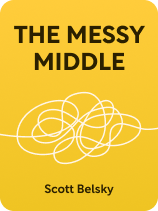

This article is an excerpt from the Shortform book guide to "The Messy Middle" by Scott Belsky. Shortform has the world's best summaries and analyses of books you should be reading.
Like this article? Sign up for a free trial here.
Why does product development take so long? What makes some products more successful than others?
Product usability plays a crucial role in determining success in the marketplace. From the initial concept to the final release, developers must balance complexity with simplicity while meeting customer demands and maintaining intuitive design.
Keep reading for insights from product development expert Scott Belsky on creating products that truly resonate with users and stand the test of time.
Product Usability
Most of Belsky’s recommendations apply to any entrepreneurial venture, but, since his experience is in product development, he offers some insights specifically for that sector. The long gestation time for any product significantly impacts the final form it takes, and successfully navigating the process is crucial for creating something truly valuable. Belsky advises that, as you spend the developmental years exploring everything your new product might do, you should focus on product usability. He emphasizes the importance of simplicity, user accessibility, and how the public will perceive your product once it’s eventually revealed.
Belsky describes a common pattern that befalls most new products—they start simple, get increasingly complicated, and then are replaced by something new and even simpler. The challenge in the middle of the development stage is to keep your product simple while adding enough features to meet your customers’ demands. Acknowledge that you’ll have to make trade-offs, such as removing older product features when you decide to add new ones. Belsky recommends identifying which aspects of your product will make it stand out and concentrating your efforts on those most impactful areas. Not every aspect of your product needs to be top-notch—only those that will be the most important to your users.
(Shortform note: Even the simplest product isn’t going to please everyone, and the trade-offs Belsky says you’ll have to make will inevitably open some doors for your business while closing others. Therefore, your trade-off decisions must be strategic. For instance, tailoring a product to suit one need makes it less capable of servicing another need. Willfully ignoring some of your customers may feel like leaving potential revenue on the table, but straddling the gap between different customer needs leads to inefficiencies that open the door for competitors to produce a better product. You sometimes have to choose not to serve all potential customers, because in trying, you’ll risk doing a poor job of serving any customers and their needs.)
Keep It Intuitive
Your temptation in the middle of the development cycle will be to push your product to do as much as it can. However, Belsky argues that creating successful products requires balancing how powerful they are and making them easy to use. He suggests basing your product decisions on the idea that the best products help people save time. Therefore, your development teams should focus on making their product features intuitive so that users can quickly have a successful experience with them. Don’t pile on features that you’ll have to explain—instead, spend your developmental years exploring ways to make using your product so natural that customers won’t even need a manual.
In the end, the long years of product development must result in a product that customers want, which is why you must take human psychology into account when designing your product and its features. Belsky notes that people are often drawn to new products because of what makes them new and exciting before deciding if they’re actually useful. Once you introduce your product, this can shape your marketing. But, during development, keep in mind that the features that excite customers at first may not be the ones they’ll most frequently use. Its most unique features give your product an edge, but Belsky recommends not losing sight of your product’s core strengths—the ones that will carry it into the future after the initial “wow factor” wears off.
| Designing for Humans The simplicity Belsky talks about isn’t easy to achieve, but it can be done. In The Design of Everyday Things, Don Norman characterizes simple, intuitive design in terms of two principles related to the user experience—discoverability and understanding. “Discoverability” refers to whether a user can figure out what an object is and how to use it. “Understanding,” on the other hand, refers to the user’s ability to make meaning out of the discoverable features of the object. Human-centered design, therefore, focuses on human needs and behaviors first, rather than designing a product and hoping that users figure out how to use it. However, simple designs don’t necessarily have to be logical. In Alchemy, marketing expert Rory Sutherland suggests that effective design can leverage humans’ illogical thinking. Just as Belsky says to play into psychology with design and market strategies, Sutherland suggests ways to tap into the instinctive, unconscious reasoning behind how people make decisions. The first tool is signaling—things you do to demonstrate your trustworthiness to others, such as using a professional-looking font in your time-management app. The second tool is the placebo effect, such as hinting that your app will make your users’ time more fun. Whether these things make logical sense is irrelevant to your users’ positive experience. |

———End of Preview———
Like what you just read? Read the rest of the world's best book summary and analysis of Scott Belsky's "The Messy Middle" at Shortform.
Here's what you'll find in our full The Messy Middle summary:
- A gravely overlooked aspect of being an entrepreneur
- The skills you need to keep your startup business afloat
- Why the middle part of starting a business is the most important






